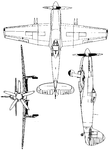Did some research, I'd heard of it briefly. But wow, my real question is can a non-swept wing aircraft really get that fast?!? http://en.wikipedia.org/wiki/Supermarine_Spiteful says top speed 494... I would have thought that compressibility and airframe strenth would have prevented it from getting to that kind of speed. That is really flippin fast.
ps sorry i dont know how to resize the picture in the thread, i didnt realize it was so big...
ps sorry i dont know how to resize the picture in the thread, i didnt realize it was so big...

